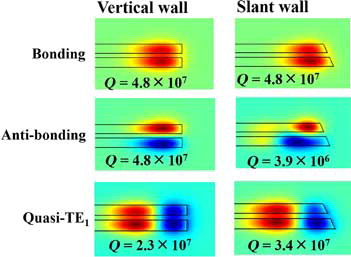ABSTRACT
We demonstrate fabrication of a high-quality factor lithium niobate double-disk whispering-gallery microcavity using femtosecond laser assisted ion beam milling. Using this method, two vertically stacked 30-µm diameter disks with a 200-nm gap are fabricated. With our device, an optical quality factor as high as 1.35 × 105 is demonstrated. Our approach is scalable to fabricate multiple disks on a single chip.
Nomenclature
| WGMs | = | whispering-gallery microcavities |
| high-Q | = | high-quality |
| Q factor | = | quality factor |
| LN | = | lithium niobate |
| FIB | = | focused ion beam |
| NA | = | numerical aperture |
| HF | = | hydrofluoric |
| SEM | = | scanning electron microscope |
| FSR | = | free spectral range |
| QED | = | quantum electrodynamics |
1. Introduction
High-quality (Q) factor whispering-gallery microcavities (WGMs) have attracted much attention for their broad range of applications ranging from optical signal processing and cavity quantum electrodynamics to biosensing and optomechanics.[Citation1Citation2Citation3Citation4Citation5Citation6Citation7Citation8Citation9Citation10] Currently, high-Q WGMs are mostly fabricated using conventional chemical etching techniques with e-beam or photo lithography, thermal reflow as well as mechanical milling and polishing technologies.[Citation11Citation12Citation13] The mechanical approach lacks the potential for monolithic integration of multiple WGMs for on-chip applications while the choice of etchant and reflow ones are limited by materials used in WGMs. For example, silica microspheres are conventionally fabricated by reflowing fiber tips using a CO2 laser as silica strongly absorbs the energy of 10-µm wavelength light emitted by such laser. Fabricating a CaF2 microsphere must take other approaches such as mechanical polishing since such material is transparent at the infrared wavelength. In fabricating silica or LiNbO3 microdisks, HF acid is used as the etchant while a different etchant such as XeF2 or SF6 is required for silicon cavity fabrication. Therefore, developing efficient fabrication techniques for producing on-chip crystalline WGMs is still challenging due to the incompatibility of a large number of crystalline materials and optical lithography. Nevertheless, it has recently been shown that femtosecond laser micromachining provides a promising approach to fabricating high-Q WGMs on various materials including glasses,[Citation14Citation15Citation16] polymers,[Citation17,Citation18] and crystals.[Citation19Citation20Citation21] It is noteworthy that the successful demonstrations of high-Q WGMs on crystalline substrates open the door for miniaturized nonlinear optics applications.
In the past few years, significant nonlinear optical phenomena and efficient electro-optic tuning effects have been experimentally demonstrated in lithium niobate (LN) WGMs.[Citation22Citation23Citation24Citation25Citation26] In addition, the capability of monolithic integration of LN microresonators with various nanophotonic structures has been reported.[Citation25Citation26Citation27] To date, only single-layered LN microdisks have been fabricated using the LN thin film substrate. It is known that silica double-disk is one of the unique structures which displays strong optomechanical effects due to the large optical gradient force provided by the strong interaction of optical fields between the top and bottom disks.[Citation28Citation29Citation30Citation31Citation32] Here, we fabricate double-disks on LN platform by utilizing a femtosecond laser in combination with focused ion beam (FIB) as the LN crystal has advantageous nonlinear optical, mechanical and electro-optical properties compared to SiO2. The unique physical properties of LN can influence the optomechanical responses in WGMs and in turn provide opportunities to new findings and applications.
2. Experiment
We designed the double-layer X-cut LN thin film substrate as illustrated in . The top and bottom LN thin films of 300 nm in thickness, respectively, are separated by a thin layer of SiO2 with a thickness of 200 nm. The double-layer LN thin film is bonded to a 2-µm thick SiO2 substrate, which is bonded to the 500-µm thick LN substrate. Following our design, the wafer was produced by NANOLN, Jinan Jingzheng Electronics Co., Ltd. A Ti:sapphire femtosecond laser source (Coherent, Inc., center wavelength: 800 nm, pulse width: 40 fs, repetition rate: 1 kHz) was used for fabricating the on-chip double-disk LN microresonator. In the femtosecond laser direct writing process, a variable neutral density filter was used to tune the average power of the laser beam, and the femtosecond laser pulse energy is adjusted to 3 μJ. An objective lens (100×/NA 0.80) was used to focus the beam down to a ∼1 µm-diameter focal spot. The sample could be arbitrarily translated in 3D space at a resolution of 1 µm using a PC-controlled XYZ stage combined with a nanopositioning stage. A charged coupled device connected to the computer was installed to monitor the fabrication process in real time.
Figure 1. The processing flow of fabricating an on-chip LN double-disk WGM. (a) Fabrication of the LN double-disk WGM using femtosecond laser microfabrication. (b) The structure obtained after the laser fabrication. (c) Focused ion beam (FIB) milling to smooth the periphery of the LN double-disk WGM. (d) The structure obtained after the FIB milling. (e) Chemical wet etching of the sample undergone the FIB milling to form the freestanding LN double-disk WGM. (f) The structure obtained after the chemical wet etching.
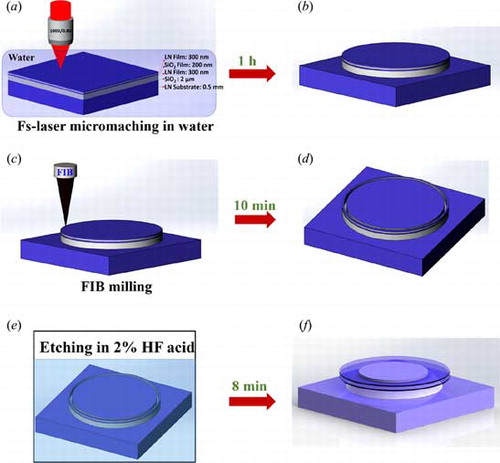
The procedures of fabricating the LN double-disk WGM are schematically illustrated in . First, the LN substrate was immersed in water and ablated with tightly focused femtosecond laser pulses, as shown in . The ablation in water can help reduce the debris and cracks in the fabricated structure. The height of the cylindrical microstructure patterned with femtosecond laser ablation is ∼5 µm, as shown in . The femtosecond laser fabrication took about 1 h. Next, the periphery of the LN double-disk WGM were smoothed using FIB milling, as illustrated in . In the FIB milling, a 30-kV ion beam with a beam current of 1 nA was used. The FIB milling was completed in 10 min. Finally, chemical wet etching, which selectively removes the SiO2 layers underneath the LN thin films to form free-standing double LN microdisks, was performed in a solution of 2% hydrofluoric (HF) for 8 min, as shown in . The SiO2 layer was partially preserved to support the double-disk LN microresonator. The diameter of the LN microdisk is 30 µm. It took about 1.5 h in total to produce the LN double-disk WGM.
3. Measurement of quality factor and analysis of WGM modes
The optical micrograph in shows the top-view image of the fabricated LN double-disk WGM. The side-view image obtained with the scanning electron micrograph (SEM) is presented in , which reveals the detailed geometry of the fabricated LN double-disk. From the right inset in , we determine that the thicknesses of top and bottom LN disks are 291 and 312 nm, respectively. An air gap of 138 nm is created between the top and bottom disks after the silica layer is partially removed by the chemical etching. In particular, from the left inset in , the sidewall of the double-disk displays a tilt angle of 26° with respect to the axis perpendicular to the double-disk plane (). This slanting sidewall is caused by the conical ion beam used in the milling process. The surface appears smooth under the SEM examination, which ensures a high-Q factor of the fabricated double-disk as we have demonstrated before.[Citation21]
Figure 2. (a) Top view optical micrograph and (b) side view SEM image of the 30-µm LN double-disk WGM fabricated with femtosecond laser micromachining combined with FIB milling.
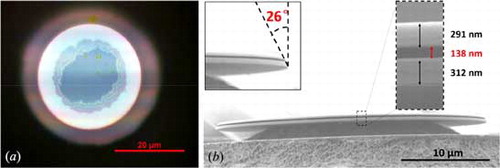
To measure the Q factor of the fabricated LN double-disk WGM, we used a system as shown in . Here, a narrow-bandwidth continuous-wave tunable diode laser (New Focus, Model 688-LN) was used as the light source. The tunable laser has a linewidth of 10 MHz in frequency, a spectral tuning range from 1510 to 1620 nm and a power of about 1 mw. The wavelength-tunable light was first coupled into and then extracted from the microdisk through a tapered optical fiber. A transient photo detector (Lafayette, Model 4650) was connected to the output of the tapered fiber for measuring the transmission spectrum. The WGM modes of quasi-TE polarization states were selectively excited using an in-line fiber polarization controller.
shows the measured transmission spectrum of a fabricated LN double-disk. As shown in the plot, a free spectral range (FSR) of 11.9 nm is observed. This is in close agreement with our simulated FSR of 12.5 nm. The zoom-in spectrum at 1528.45 nm is shown in ) where mode splitting is observed. Based on a Lorentzian fitting, the Q factors of the splitting modes were determined to be 1.35 × 105 and 1.21 × 105.[Citation33] Another zoom-in spectrum shown in further displays a single resonance mode with Q of 1.06 × 105 at 1552.20 nm. The result clearly shows that our LN double-disk can have a high Q factor on the same level of that of single-disk LN microresonator.
Figure 4. (a) Normalised transmission spectrum of the LN double-disk. The Lorentzian fittings showing (b) mode splitting with two similar Q-factors of 1.35 × 105 and 1.21 × 105 as measured around 1528.45 nm, and (c) a Q-factor of 1.06 × 105 as measured at 1552.20 nm.
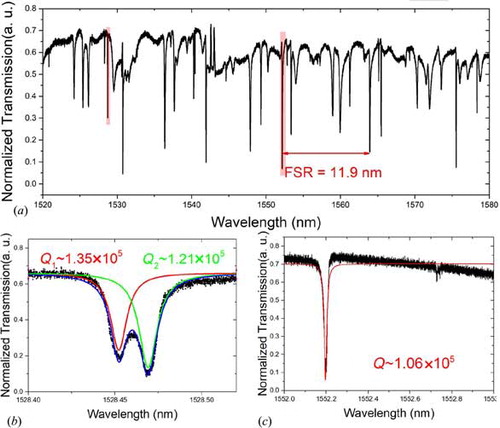
Furthermore, we attempted to identify some of the modes with numerical simulations. shows a recorded transmission spectrum of another LN disk at 1573.22 nm (i.e., the black curve), from which an overall optical Q-factor of 1.2 × 105 can be determined with Lorentz fitting curve in red. Here, a full vector WGM mode solver was implemented using COMSOL 2D axisymmetric, wave optics frequency domain electromagnetics module. In this simulation, we assume the refractive index of LN to be .[Citation34] The edge of the double disk is centered in an 8-µm wide and 3-µm high computation window. To minimize the spurious reflection, 1.55-µm thick perfect match layers were added at the edges of the window. The inset in shows the simulated WGM profile in the double disk, which corresponds to the fundamental quasi-TE mode at an azimuthal order of 102 at a resonance wavelength of 1572.16 nm. The resonant wavelengths obtained from experimental measurement and simulation nicely agree with each other, indicating that the measured mode is highly likely to be the mode shown in the inset. The slight difference in resonance wavelengths between the experiment and simulation can be attributed to the perturbation from the fiber taper, which can be modeled through perturbation[Citation35] or mode matching methods.[Citation36,Citation37] We note that due to the existence of high-order modes and lack of full geometric information of the double-disk microcavity, complete determination of the modes by measurements requires more sophisticated techniques, which will be practiced in the future. The simulation also indicated an optical Q of 4.8 × 107 after only considering the absorption loss, corresponding to the ultimate Q value of such devices after optimizing our fabrication processes (i.e., by suppressing the scattering loss at the sidewalls as much as possible).
Figure 5. Q-factors of (a) 1.2 × 105 measured at 1573.22 nm and (b) 3.6 × 104 measured at 1566.13 nm. The corresponding mode profiles revealed by the simulations are shown in the insets.
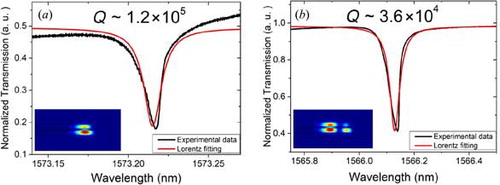
Furthermore, shows another measured Q-factor of 3.6 × 104 at 1566.13 nm, which is derived from Lorentz fitting as well. According to the simulation, the experimentally observed mode in may be attributed to a high order transverse mode at an azimuthal order of 96 with a resonance wavelength of 1565.91 nm. In contrast to the result reported in Lin et al.[Citation29] our simulations show that the wedge angle leads to degradation of Q for antibond modes by an order of magnitude. For illustration, we have also conducted a set of comparative simulations on two types of double disks with either a vertical or a slant wall. Here, the simulation parameters of both disks are the same as in except for the wedge angles. As shown in , when the disk edge is vertical, the antibonding mode has a Q similar to the bonding mode. This is consistent with previously published results.[Citation29] However, our device displayed a slant edge as shown in . As indicated by our simulation results in , this will degrade Q by an order of magnitude, much lower than the higher-order mode displayed in the inset of (b). Since higher Q modes are easier to be excited, we believe that the mode we observed is more likely to be the higher-order mode while the antibond mode was unlikely to be excited in our LN double-disk structure.
4. Conclusion
To conclude, we have demonstrated fabrication of LN double-disks of Q factors on the order of 105. Our technique combines femtosecond laser direct writing and FIB milling, thereby providing both high fabrication efficiency and ultra-high fabrication resolution. We envisage that such device is an excellent platform for the study of cavity quantum electrodynamics (QED) where the LN provides another dimension of control to the corresponding experiments. In future researches, we will exploit the unique electro-optical and nonlinear optical properties of such device to provide the tunability for investigating cavity optomechanics and nonlinear optics.[Citation26] For example, we can electrically control the refractive index of LN microcavity in real-time for tuning or locking optomechanical frequency. The strong nonlinear effects displayed from LN further enable us to study the intriguing interplay between optomechanics and nonlinear optical phenomenon.
Acknowledgments
Tao Lu would like to acknowledge Natural Sciences and Engineering Research Council of Canada (NSERC) Discovery (RGPIN-2015-06515) and CMC Microsystems.
Additional information
Funding
References
- Vahala, K. J. Optical Microcavities. Nature 2006, 424, 839–846.
- Kippenberg, T. J.; Spillane, S. M.; Vahala, K. J. Kerr-Nonlinearity Optical Parametric Oscillation in an Ultrahigh-Q Toroid Microcavity. Phys. Rev. Lett. 2004, 93, 083904.
- Aoki, T., Dayan, B.; Wilcut, E.; Bowen, W. P.; Parkins, A. S.; Kippenberg, T. J.; Vahala, K. J.; Kimble, H. J. Observation of Strong Coupling Between One Atom and a Monolithic Microresonator. Nature 2006, 443, 671–674.
- Lu, T., Lee, H.; Chen, T.; Herchak, S.; Kim, J.-H.; Fraser, S. E.; Flagan, R. C.; Vahala, K. J. High Sensitivity Nanoparticle Detection Using Optical Microcavities. Proc. Natl. Acad. Sci. U. S. A 2011, 108, 5976–5979.
- Yu, W.; Jiang, W. C.; Lin, Q.; Lu, T. Cavity Optomechanical Spring Sensing of Single Molecules. Nat. Commun. 2016, 7, 12311.
- Kippenberg, T. J.; Vahala, K. J. Cavity Optomechanics: Back-Action at the Mesoscale. Science 2008, 321, 1172–1176.
- Aspelmeyer, M.; Kippenberg, T. J.; Marquardt, F. Cavity Optomechanics. Rev. Mod. Phys. 2014, 86, 1391.
- Fan, X.; White, I. M.; Shopova, S. I.; Zhu, H.; Suter, J. D.; Sun, Y. Sensitive Optical Biosensors for Unlabeled Targets: A Review. Anal. Chim. Acta 2008, 620, 8.
- Dantham, V. R.; Holler, S.; Barbre, C.; Keng, D.; Kolchenko, V.; Arnold, S. Label-Free Detection of Single Protein Using a Nanoplasmonic-Photonic Hybrid Microcavity. Nano Lett. 2013, 13, 3347.
- Baaske, M. D.; Foreman, M. R.; Vollmer, F. Single-Molecule Nucleic Acid Interactions Monitored on a Label-Free Microcavity Biosensor Platform. Nat. Nanotechnol. 2014, 9, 933.
- Armani, D. K.; Kippenberg, T. J.; Spillane, S. M.; Vahala, K. J. Ultra-High-Q Toroid Microcavity on a Chip. Nature 2003, 421, 925.
- Savchenkov, A. A.; Ilchenko, V. S.; Matsko, A. B.; Maleki, L. Kilohertz Optical Resonances in Dielectric Crystal Cavities. Phys. Rev. A 2004, 70, 051804.
- Fürst, J. U.; Strekalov, D. V.; Elser, D.; Lassen, M.; Andersen, U. L.; Marquardt, C.; Leuchs, G. Naturally Phase-Matched Second-Harmonic Generation in a Whispering-Gallery-Mode Resonator. Phys. Rev. Lett. 2010, 104, 153901.
- Lin, J.; Yu, S.; Ma, Y.; Fang, W.; He, F.; Qiao, L.; Tong, L.; Cheng, Y.; Xu, Z. On-Chip Three-Dimensional High-Q Microcavities Fabricated by Femtosecond Laser Direct Writing. Opt. Express 2012, 20, 10212–10217.
- Lin, J.; Xu, Y.; Song, J.; Zeng, B.; He, F.; Xu, H., Sugioka, K.; Fang, W.; Cheng, Y. Low-Threshold Whispering-Gallery-Mode Microlasers Fabricated in a Nd: Glass Substrate by Three-Dimensional Femtosecond Laser Micromachining. Opt. Lett. 2013, 38, 1458–1460.
- Tielen, V.; Bellouard, Y. Three-Dimensional Glass Monolithic Micro-Flexure Fabricated by Femtosecond Laser Exposure and Chemical Etching. Micromachines 2014, 5, 697–710.
- Liu, Z. P.; Li, Y.; Xiao, Y. F.; Li, B. B.; Jiang, X. F.; Qin, Y.; Feng, X. B.; Gong, Q. Direct Laser Writing of Whispering Gallery Microcavities by Two-Photon Polymerization. Appl. Phys. Lett. 2010, 97, 211105.
- Zhan, X. P.; Ku, J. F.; Xu, Y. X.; Zhang, X. L.; Zhao, J.; Fang, W.; Xu, H. L. Sun, H. B. Unidirectional Lasing from a Spiral-Shaped Microcavity of Dye-Doped Polymers. IEEE Photonics Technol. Lett. 2015, 27, 311–314.
- Lin, J.; Xu, Y.; Tang, J.; Wang, N.; Song, J.; He, F.; Fang, W.; Cheng, Y. Fabrication of Three-Dimensional Microdisk Resonators in Calcium Fluoride by Femtosecond Laser Micromachining. Appl. Phys. A 2014, 116, 2019–2023.
- Lin, J.; Xu, Y.; Fang, Z.; Wang, M.; Wang, N.; Qiao, L.; Fang, W.; Cheng, Y. Second Harmonic Generation in a High-Q Lithium Niobate Microresonator Fabricated by Femtosecond Laser Micromachining. Sci. China-Phys. 2015, 58, 114209.
- Lin, J. T.; Xu, Y. X.; Fang, Z. W.; Wang, M.; Song, J. X.; Wang, N. W.; Qiao, L. L.; Fang, W.; Cheng, Y. Fabrication of High-Q Lithium Niobate Microresonators Using Femtosecond Laser Micromachining. Sci. Rep. 2015, 5, 8072.
- Wang, C.; Burek, M. J.; Lin, Z.; Atikian, H. A.; Venkataraman, V.; Huang, I. C.; Stark, P.; Lončar, M. Integrated High Quality Factor Lithium Niobate Microdisk Resonators. Opt. Express 2014, 22, 30924–30933.
- Wang, J.; Bo, F.; Wan, S.; Li, W. X.; Gao, F.; Li, J. J.; Zhang, G. Q.; Xu, J. J. High-Q Lithium Niobate Microdisk Resonators on a Chip for Efficient Electro-Optic Modulation. Opt. Express 2015, 23, 23072–23078.
- Lin, J. T.; Xu, Y. X.; Ni, J. L.; Wang, M.; Fang, Z. W.; Qiao, L. L.; Fang, W.; Cheng, Y.. Phase-Matched Second-Harmonic Generation in an On-Chip LiNbO3 Microresonator. Phys. Rev. Appl. 2016, 6, 014002.
- Guarino, A.; Poberaj, G.; Rezzonico, D.; Degl’Innocenti, R.; Gunter, P. Electro-Optically Tunable Microring Resonators in Lithium Niobate. Nat. Photon. 2007, 1, 407–410.
- Wang, M.; Xu, Y.; Fang, Z.; Liao, Y.; Wang, P.; Chu, W.; Qiao, L.; Lin, J.; Fang, W.; Cheng, Y. On-Chip Electro-Optic Tuning of a Lithium Niobate Microresonator with Integrated In-Plane Microelectrodes. Opt. Express 2017, 25, 124–129.
- Fang, Z.; Xu, Y.; Wang, M.; Qiao, L.; Lin, J.; Fang, W.; Cheng, Y. Monolithic Integration of a Lithium Niobate Microresonator with a Free-Standing Waveguide Using Femtosecond Laser Assisted Ion Beam Writing. Sci. Rep. 2017, 7, 45610.
- Rosenberg, J.; Lin, Q.; Painter, O. Static and Dynamic Wavelength Routing Via the Gradient Optical Force. Nat. Photon. 2009, 3, 478–483.
- Lin, Q.; Rosenberg, J.; Jiang, X.; Vahala, K. J.; Painter, O. Mechanical Oscillation and Cooling Actuated by the Optical Gradient Force. Phys. Rev. Lett. 2009, 103, 103601.
- Wiederhecker, G. S.; Chen, L.; Gondarenko, A.; Lipson, M. Controlling Photonic Structures Using Optical Forces. Nature 2009, 462, 633–638.
- Van Thourhout, D.; Roels, J. Optomechanical Device Actuation Through the Optical Gradient Force. Nat. Photon. 2010, 4, 211–217.
- Jiang, X.; Lin, Q.; Rosenberg, J.; Vahala, K.; Painter, O. High-Q Double-Disk Microcavities for Cavity Optomechanics. Opt. Express 2009, 17, 20911–20919.
- Gorodetsky, M. L.; Pryamikov, A. D.; Ilchenko, V. S. Rayleigh Scattering in High-Q Microspheres. J. Opt. Soc. Am. B 2000, 17, 1051–1057.
- Dmitriev, V. G.; Gurzadyan, G. G.; Nikogosyan, D. N. Handbook of Nonlinear Optical Crystals; Springer - Verlag Berlin Heidelberg GmbH, 2013.
- Teraoka, I.; Arnold, S.; Vollmer, F. Perturbation Approach to Resonance Shifts of Whispering-Gallery Modes in a Dielectric Microsphere as a Probe of a Surrounding Medium. J. Opt. Soc. Am. B 2003, 20, 1937.
- Du, X.; Vincent, S.; Lu, T. Full-Vectorial Whispering-Gallery-Mode Cavity Analysis. Opt. Express 2013, 21, 22012.
- Du, X.; Vincent, S.; Faucher, M.; Picard, M. J.; Lu, T. Generalized Full-Vector Multi-Mode Matching Analysis of Whispering Gallery Microcavities. Opt. Express 2014, 22, 13507.


